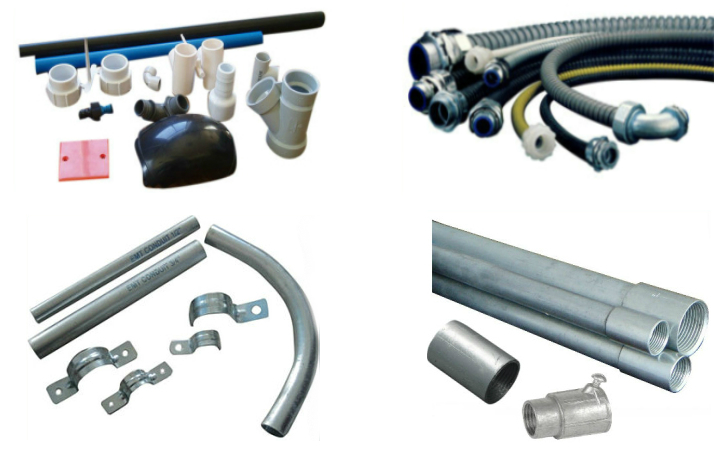Electrical conduits are metal, plastic or fiber pipes designed to protect electrical cables and wires. They’re used in just about every residential and commercial establishment, especially for wiring that is either exposed, or fitted outdoors. Since they are essentially a safety feature, you should select the material, size and fittings based on the environment of the installation and the type of wiring it’ll be housing.

Types of Electrical Conduits
When it comes to options, there are almost as many types of conduits as there are wires and cables, and they can be broadly classified into metallic and nonmetallic variants. Here are some of the most common types under these categories:
Metallic Conduits
Non-Metallic Conduits
To ensure the conduit system meets the requirements of regulatory authorities, safety standards and local building codes, you need to take into account the conditions at the installation location, as well as the method of installation. Some installations may also require different types of conduits to be used in the same system.
Conduit Fittings
Conduit fittings are available in a huge variety of sizes, shapes and materials, and they’re normally used for connecting runs of conduit together, and for connecting conduit ends to boxes, enclosures or electrical devices. Fittings are needed to connect conduits to boxes or enclosures of different sizes and when the direction of most metallic conduits has to be changed. There are also straps and clamps, which are used to provide additional support to conduits and to keep them secured. You may need to use special types of fittings if a conduit run is likely to be exposed to moisture, vapors, or hazardous conditions.
Types of Electrical Fittings
Section 110-3 of the NEC requires all the components to be listed and labelled, so all listed parts meet certain construction and performance requirements. However, the Code does not specify the electrical material used for the fittings, of which there are several. This will be determined by availability, design considerations or personal preference. If you’re unsure about how the conditions will affect the fittings, you can contact a manufacturer with details of your application, consult a local distributor, or get an engineering recommendation.
Electrical Conduit fittings can be listed as follows, based on the function they serve and how they are installed:
FAQs
1. What does conduit serve in electrical wiring?
There are multiple benefits to utilizing an electrical conduit. It protects the wires by enclosing them in a sturdy tube, preventing damage or exposure to harmful conditions. This reduces the chances of electric shocks and fires resulting from faulty wiring. Electrical conduits can also be utilized for organizing and decluttering purposes, as they allow multiple cables to be routed in one location. Additionally, they offer an attractive aesthetic element to any project due to their wide range of colors and sizes.
2. How deep must electrical conduit be buried?
In most cases, it’s recommended to bury conduit at least 18 inches deep. However, there may be some exceptions where it needs to be buried even deeper.
3. What are some common types of electrical conduit?
You can find electrical conduits in various materials such as aluminum, steel, PVC (polyvinyl chloride), and flexible conduits.
4. How do you bend an electrical conduit?
You can bend electrical conduit like an expert if you follow these simple instructions:
Step 1 – Calculate your conduit bend’s exact angle and position to ensure an accurate and professional installation.
Step 2 – On the conduit, mark the calculated bend point. During the bending process, this can serve as a guide.
Step 3 – Carefully apply pressure to the designated place with a conduit bender and gradually bend the conduit to the appropriate angle.
Step 4 – Double-check your work when the bending procedure is finished. Check for kinks and deformities in the conduit and ensure it is at the proper angle.
5. How to Connect PVC Conduit to Electrical Box?
Follow these easy instructions to connect PVC conduit to the electrical box:-
- Before you begin, switch off the power to the circuit.
- Using a hacksaw or PVC pipe cutter, measure and cut the PVC conduit to the necessary length.
- Remove any rough edges or burrs from the cut end of the conduit with a deburring tool or a utility knife.
- Slide the proper fittings onto the conduit. A male adapter and a locknut are required for a standard connection to an electrical box.
- Apply PVC cement to the inside of the female threads on the electrical box and the exterior of the male adapter.
- Tighten the male adapter into the female threads on the electrical box.
- Once the conduit is attached to the electrical box, use a fish tape or a wire-pulling tool to fish the wiring through the conduit. To avoid harming the wires, take your time and be gentle.
6. What types of wires were used with conduits?
THHN and THWN are the two most popular wire kinds used within a conduit. These wires are insulated, color-coded, and available in single strands. They resemble the wires seen when the outer coating of the NM cable is removed.
7. Is it okay to use white PVC for electrical conduit?
According to the NFPA/NEC codes, using “white” plumbing PVC for electrical raceways is not advisable. This is because “grey” electrical PVC is UV resistant, while “white” plumbing PVC is not. UL (Underwriters Laboratory) designates “grey” PVC as an authorized electrical raceway.
8. Are electrical conduits and BX wires the same thing?
At first glance, an electrical conduit might look like a BX wire. The BX wire is often known as AC wiring for “armored cable” or MC wiring for “metal cable.” Both AC and MC wiring have individual wires enclosed in a metal casing, similar to the conduit. However, there is a key difference – While conduit can be used in exposed and moist areas, armored cable should not be used in wet locations. These places are prone to corrosive conditions where damage could occur, as stated in the electrical code (NEC 320.12)
9. Is conduit required for electrical lines in walls?
You’ll likely want to use a conduit when running electrical wires through walls. It’s imperative because it helps protect the wires from damage or fire hazards. And if you are extending cables outdoors, using conduit to shield them from the unpredictable weather is crucial.
10. Is it necessary to run 220v wiring through a conduit?
Protecting the wires for your 220 lines is essential to keep yourself safe from harm. Exposing them outside your walls can lead to severe injury or death. So, grab some stiff metal conduit long enough to go from the side of your breaker box to the hole you made in the wall. Then, securely fasten it with conduit straps every 1-2 feet (30-61 cm). This way, you can ensure that your wires are well-protected.
11. What is the strength of an electrical conduit?
The conduit has a minimum yield strength of 30,000 psi. This ensures that the conduit doesn’t “neck down” while being installed, which could cause damage to the cable or conductors.
